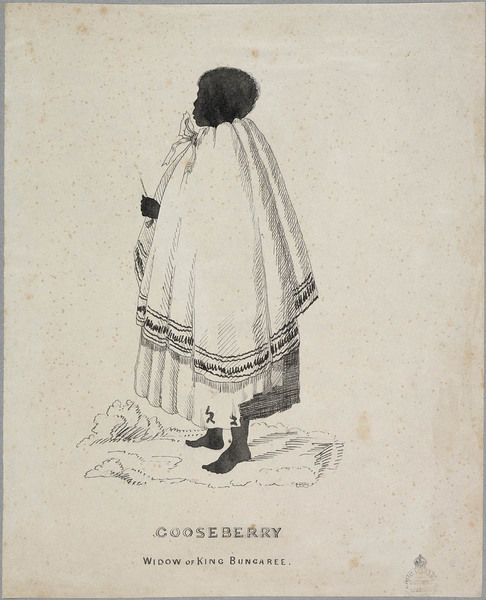Earle, Augustus, 1793-1838.
The annual meeting of the Aboriginal tribes at Parramatta,
New South Wales, the Governor meeting them [picture]
[1826?] 1 watercolour ; 17.1 x 26 cm. (National Library of Australia)
On the 28 December 1814 Governor Macquarie organised a meeting with local tribes at Parramatta to discuss the enrollment of children in a newly formed "Asylum for Native Children". At one o'clock Macquarie and his wife, accompanied by a number of civil and military officers, arrived at the market place adjacent to St John's Cathedral. After talking for an hour to overcome the suspicions of the local aborigines three children were finally yielded up to the project and a meal of roast beef and ale was provided to those in attendance.
From 1822 until 1830 there was an annual meeting held in the Parramatta marketplace attended by the Governor of the time, his family, and Aboriginal Tribes from various areas. These included Parramatta, Concord, Kissing Point, Prospect, Eastern Creek and as far away as Jervis Bay and Shoalhaven. Successive governors continued the tradition inviting the leaders of various Aboriginal tribes including: Boongaree, Windradyne, Bungaree, Blang, Dual, Cogle.
These feasts were held 28 December or early January and members of the tribes were given soup, roasted beef, vegetables, bread, and plum pudding, alcohol and sweets. The men of the tribes were then given a plentiful supply of tobacco and the women European dresses. In 1832 the setting was given a more formal touch with white tablecloths and each attendee receiving a tin plate, knife, fork and a goblet.
Over the lifetime of the feasts other items including hats,
trousers, shirts, petticoats, and blankets were also added to the list of gifts.
It was this gift of blankets that from the 1830’s began to be used to provide a
type of census of the Aboriginal people of the area. The annual gatherings appear to have been enjoyed
by many of the tribes who attended and were referred to by some as ‘payalla’ as
it was an opportunity for settling quarrels among tribes and individuals. This settling
of disputes was also observed by Joseph Holt between 1800 and 1812 who pointed
out the now obvious fact that these meetings occurred long before Europeans set
the agenda for a feast day. According to Holt … “the men painted themselves with white pipe clay and red ochre…the two
parties advanced towards each other … armed with spears, boomerangs,
mullah-mullahs, waddies and shields … next day both parties assembled at the
feast together and made friends.”
It was Major General Bourke who eventually decided that clothes would be a better gift at these events especially if they were received during the
winter and as a result he rescheduled the timing of the event to May.
[Sketches
of Aborigines of New South Wales, ca. 1836 / attributed to W.H. Fernyhough]
5.
Goosberry, Widow of King BungareeDigital Order Number: a1108006 (State Library of NSW)
Emma Stockburn, Family History Librarian, Parramatta Council Heritage Centre, 2014
References:
- Place of Eels: Parramatta and Aboriginal Clans of the Sydney Region: 1788-1845, Michael Flynn: (LS 994.4102/FLY)
- The Parramatta Native Institution and the Black town : a history, Jack Brook, (LS 994.413 BROO)
- A Rum Story: the Adventures of Joseph Holt: edited by Peter O’Shaughnessy (LS 994402092 HOL)
- THE GOVERNOR'S ANNUAL CONFERENCE WITH THE NATIVES. (1832, January 12). The Sydney Gazette and New South Wales Advertiser (NSW : 1803 - 1842), p. 2. Retrieved January 30, 2014, from http://nla.gov.au/nla.news-article2204436
- CONFERENCE WITH THE BLACK NATIVES. (1832, January 13). The Australian (Sydney, NSW : 1824 - 1848), p. 3. Retrieved January 30, 2014, from http://nla.gov.au/nla.news-article42007530
- Proclamation,. (1816, May 18). The Sydney Gazette and New South Wales Advertiser (NSW : 1803 - 1842), p. 1. Retrieved January 30, 2014, from http://nla.gov.au/nla.news-article2176655
- CORROBORIE AT PARRAMATTA. (1828, January 4). The Australian (Sydney, NSW : 1824 - 1848), p. 3. Retrieved February 27, 2014, from http://nla.gov.au/nla.news-article37071315
- State archives relating to Aboriginal People: Part Two - Agencies relating to Aboriginal People http://www.records.nsw.gov.au/state-archives/guides-and-finding-aids/archives-relating-to-aboriginal-people/part-two-agencies-relating-to-aboriginal-people/part-two-agencies-relating-to-aboriginal-people




No comments:
Post a Comment
We value your comments and thank you for taking the time to add to the content on this site.